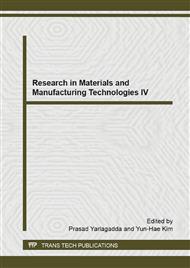[1]
T. Ando, High-speed atomic force microscopy coming of age, Nanotechnology, vol. 23, no. 6, p.062001, Feb 17, (2012).
DOI: 10.1088/0957-4484/23/6/062001
Google Scholar
[2]
T. Ando, T. Uchihashi, and T. Fukuma, High-speed atomic force microscopy for nano-visualization of dynamic biomolecular processes, Progress in Surface Science, vol. 83, no. 7-9, pp.337-437, (2008).
DOI: 10.1016/j.progsurf.2008.09.001
Google Scholar
[3]
C. Gerber, and H. P. Lang, How the doors to the nanoworld were opened, Nature nanotechnology, vol. 1, no. 1, pp.3-5, (2006).
DOI: 10.1038/nnano.2006.70
Google Scholar
[4]
Y. Yong, and S. Mohemani, Design of an Inertially Counterbalanced Z-Nanopositioner for High-Speed Atomic Force Microscopy, IEEE TRANSACTIONS ON NANOTECHNOLOGY, vol. 12, no. 2, p.137, (2013).
DOI: 10.1109/tnano.2012.2233749
Google Scholar
[5]
Y. K. Yong, S. O. Moheimani, B. J. Kenton et al., Invited review article: high-speed flexure-guided nanopositioning: mechanical design and control issues, Rev Sci Instrum, vol. 83, no. 12, p.121101, Dec, (2012).
DOI: 10.1063/1.4765048
Google Scholar
[6]
B. J. Kenton, and K. K. Leang, Design and control of a three-axis serial-kinematic high-bandwidth nanopositioner, Mechatronics, IEEE/ASME Transactions on, vol. 17, no. 2, pp.356-369, (2012).
DOI: 10.1109/tmech.2011.2105499
Google Scholar
[7]
B. J. Kenton, A. J. Fleming, and K. K. Leang, Compact ultra-fast vertical nanopositioner for improving scanning probe microscope scan speed, Rev Sci Instrum, vol. 82, no. 12, p.123703, Dec, (2011).
DOI: 10.1063/1.3664613
Google Scholar
[8]
A. J. Fleming, B. J. Kenton, and K. K. Leang, Bridging the gap between conventional and video-speed scanning probe microscopes, Ultramicroscopy, vol. 110, no. 9, pp.1205-14, Aug, (2010).
DOI: 10.1016/j.ultramic.2010.04.016
Google Scholar
[9]
T. Fukuma, Y. Okazaki, N. Kodera et al., High resonance frequency force microscope scanner using inertia balance support, Applied Physics Letters, vol. 92, no. 24, p.243119, (2008).
DOI: 10.1063/1.2951594
Google Scholar
[10]
G. E. Fantner, G. Schitter, J. H. Kindt et al., Components for high speed atomic force microscopy, Ultramicroscopy, vol. 106, no. 8-9, pp.881-7, Jun-Jul, (2006).
DOI: 10.1016/j.ultramic.2006.01.015
Google Scholar
[11]
T. Ando, N. Kodera, D. Maruyama et al., A High-Speed Atomic Force Microscope for Studying Biological Macromolecules in Action, Japanese Journal of Applied Physics, vol. 41, no. Part 1, No. 7B, pp.4851-4856, (2002).
DOI: 10.1143/jjap.41.4851
Google Scholar
[12]
T. Ando, N. Kodera, E. Takai et al., A high-speed atomic force microscope for studying biological macromolecules, Proc Natl Acad Sci U S A, vol. 98, no. 22, pp.12468-72, Oct 23, (2001).
DOI: 10.1073/pnas.211400898
Google Scholar


